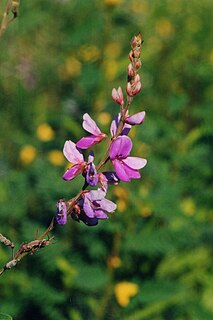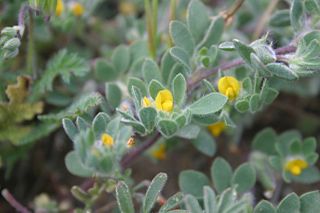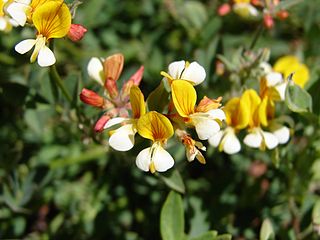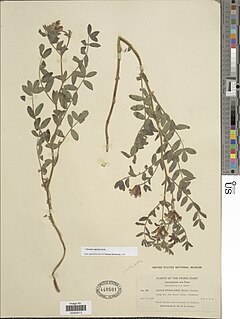
Lotus, a latinization of Greek lōtos, is a genus of flowering plants that includes most bird's-foot trefoils and deervetches and contains many dozens of species distributed worldwide. Depending on the taxonomic authority, roughly between 70 and 150 are accepted. Lotus is a genus of legumes and its members are adapted to a wide range of habitats, from coastal environments to high altitudes.

Lotus corniculatus is a flowering plant in the pea family Fabaceae, native to grasslands in temperate Eurasia and North Africa. Common names include common bird's-foot trefoil, eggs and bacon, birdsfoot deervetch, and just bird's-foot trefoil, though the latter name is often also applied to other members of the genus.

Cassia fistula, commonly known as golden shower, purging cassia, Indian laburnum, or pudding-pipe tree, is a flowering plant in the subfamily, Caesalpinioideae of the legume family, Fabaceae. The species is native to the Indian subcontinent and adjacent regions of Southeast Asia. It ranges from eastward throughout India to Myanmar and Thailand and south to Sri Lanka and southern Pakistan. It is a popular ornamental plant and is also used in herbal medicine. It is both the national tree and national flower of Thailand. It is the state flower of Kerala in India. It is the provincial flower of North Central Province in Sri Lanka.

Acmispon glaber is a perennial subshrub in the family Fabaceae. The plant is a pioneer species found in dry areas of California, Arizona, and Mexico. It is commonly found in many areas including chaparral, coastal sand and roadsides at elevations below 1500 m.

Albizia julibrissin, the Persian silk tree or pink silk tree, is a species of tree in the family Fabaceae, native to southwestern and eastern Asia.

Lupinus sulphureus is a species of lupine, a flowering plant of the legume family, Fabaceae.

Desmodium canadense is a species of flowering plant in the legume family, Fabaceae. It is native to eastern North America. Its common names include showy tick-trefoil, Canadian tick-trefoil, and Canada tickclover.

Medicago lupulina, commonly known as black medick, nonesuch, or hop clover, is a plant of dry grassland belonging to the legume or clover family. Plants of the genus Medicago, or bur clovers, are closely related to the true clovers (Trifolium) and sweet clover (Melilotus). Like the true clovers, black medick has three leaflets and a small, yellow flower closely resembling those of lesser trefoil. Black medick belongs to the same genus as alfalfa.

Clitoria ternatea, commonly known as Asian pigeonwings, bluebellvine, blue pea, butterfly pea, cordofan pea and Darwin pea, is a plant species belonging to the family Fabaceae.

Plebejus idas, the Idas blue or northern blue, is a butterfly of the family Lycaenidae.
Acmispon argyraeus, synonym Lotus argyraeus, is a species of legume native to California and northwest Mexico. It is known by the common name canyon bird's-foot trefoil. It occurs in dry mountain habitat. It is a perennial herb lined with leaves each made up of a few oval leaflike leaflets about 1 cm long. Most of the plant is silky-hairy in texture. The inflorescence holds one to three pinkish-yellow flowers roughly 1 cm long. The fruit is a dehiscent legume pod up to 2.5 cm long.
Acmispon denticulatus is a species of legume known by the common name riverbar bird's-foot trefoil. It is native to western North America from British Columbia to California to Utah, where it grows in moist spots in a number of habitat types. It is an annual herb growing erect or spreading to about 40 cm in maximum length. It is lined with leaves each made up of a few alternately arranged oval leaflets 1 to 2 cm long, sometimes slightly hairy in texture. The inflorescence is made up of one or two whitish to yellowish pealike flowers located in leaf axils. The fruit is a hairy legume pod up to about 1.5 cm long.

Hosackia gracilis, synonym Lotus formosissimus, is a species of legume native to western North America from British Columbia through Washington and Oregon to California. It was first described by George Bentham. It is known by the common names harlequin lotus and seaside bird's-foot trefoil. It grows in moist spots in the coastal mountains and down to the oceanside bluffs. It is a perennial herb growing upright or spreading to about 0.5 m in maximum length. It is lined with leaves each made up of a few oppositely arranged oval leaflets up to 2 cm long. The inflorescence is made up of several pealike flowers each 1 to 2 cm long. The flower has a bright yellow banner, or upper petal, and bright pink or white lower petals. The fruit is a legume pod 2 to 3 cm long.

Acmispon brachycarpus is a species of legume known by the common name foothill deervetch. It is native to western North America from Idaho to Texas to northern Mexico, where it is known from many types of habitat. It is an annual herb spreading upright or taking a clumpy or matted form. It is lined with leaves each usually made up of four hairy, somewhat fleshy leaflets each up to about 1 cm long. Solitary yellow, pea-like flowers appear in the leaf axils. The fruit is a legume pod variable in size and shape.
Hosackia incana, synonym Lotus incanus, is a species of legume native to California. It is known by the common name woolly bird's-foot trefoil. It is endemic to the Sierra Nevada of California, where it grows in forests and other mountain habitat.

Hosackia oblongifolia, synonym Lotus oblongifolius, is a species of legume native to western North America from Oregon to northern Mexico. It is known by the common name streambank bird's-foot trefoil or meadow lotus. It grows in moist to wet areas in several types of habitat. It is a spreading or upright perennial herb lined with leaves each made up of 3 elongated oval leaflets each up to 2.5 centimeters long. The inflorescence bears several yellow and white flowers between 1 and 2 centimeters long. The fruit is very elongated, reaching up to 5 centimeters in length but just a few millimeters in width.
Hosackia pinnata, synonym Lotus pinnatus, is a species of legume native to western North America from British Columbia to California. It is known by the common names meadow bird's-foot trefoil and bog bird's-foot trefoil. Its distribution extendsg into British Columbia in just a few rare occurrences near Nanaimo. It grows in moist to wet habitat, such as bogs and spring meadows. It is a hairless perennial herb lined with leaves each made up of green oval leaflets each 1 to 2.5 centimeters in length. The inflorescence is an array of up to 10 pealike flowers between 1 and 2 centimeters long. Each flower has a bright yellow banner, or upper petal, and white lower petals. The fruit is a slender, elongated legume pod up to 5 centimeters long but just a few millimeters long.

Hosackia stipularis, synonym Lotus stipularis, is a species of legume endemic to California. It is known by the common name balsam bird's-foot trefoil. It is found in most of the northern and central coastal and inland mountain ranges and foothills. It can be found in many types of habitat, including forest, chaparral, and disturbed areas. This is a mostly erect perennial herb with a leafy, often hairy and glandular form. Its slender branches are lined with leaves each made of several leaflets up to 2 centimeters long. The leaves sometimes have prominent stipules. The inflorescence is a compact array of up to 9 pink flowers. Each flower is elongated, the corolla borne in a tubular calyx of sepals, and the entire unit may exceed a centimeter long. The fruit is a legume pod 2 or 3 centimeters long containing several beanlike seeds.

Hosackia is a genus of flowering plants in the family Fabaceae (legumes). It is native to western North America, from British Columbia in Canada to Mexico.













